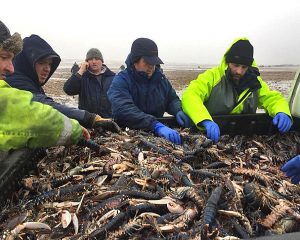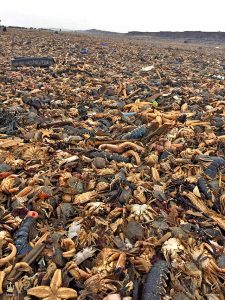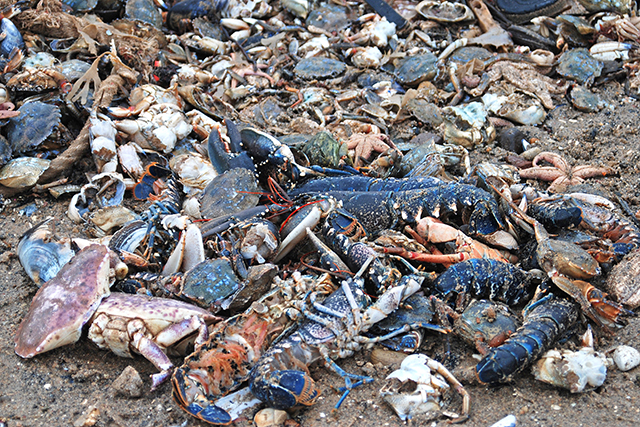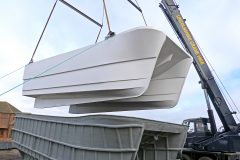Fishermen and their families, together with volunteers from Yorkshire Wildlife Trust and members of the general public, rescued over 5,000 lobsters washed ashore on the Holderness coast by extremely heavy seas associated with the ‘Beast From The East’ and Storm Emma at the beginning of this month, reports John Worrall.

Local fishermen, Don White, Chris Thorpe, Jack Sanderson, James Haxby and Kyle Formby loading lobsters washed ashore in South Yorkshire into a pick up before they were revived in shellfish storage tanks at Bridlington. (Photo: Bex Lynam, Yorkshire Wildlife Trust)
Large numbers of live lobsters, together with other fish and shellfish, started to be washed up onto beaches south of Bridlington in the early hours of Saturday, 3 March, when sea conditions were still extremely poor.
It is thought that with the sudden drop in water temperature – by 3°C or so – as sub-zero easterly gales originating from Siberia became established, the wildlife had become torpid and less inclined – or able – to hold ground and resist being washed inshore by wave action.
Such wash-ups do occur on that coast after onshore winds and rough seas, but rarely on the scale experienced in the aftermath of the consecutive storms, and not usually until the weather moderates. The fact that casualties began to appear when big seas were still running, alerted local fishermen to the likely degree of damage.
Bridlington skipper Ben Woolford was one of the fishermen who read the signs.
“When you get a wash-up, you don’t usually get it until the sea begins to fall away. When the weather is still poor, it’s like a washing machine and everything is going in and out with the tide. It’s not until the sea settles that it starts dropping things on the beach. Looking at the forecast, none of us really expected anything would start washing up until Sunday. But when we heard that a lot of lobsters were appearing on Saturday morning, we knew it was going to be something.”
The focus of the wash-up was near Fraisthorpe three or four miles down the coast from Bridlington, but over half a mile from the nearest road access.
“A few of us went down there early on Saturday, and when we saw the amount of lobster on the beach, much of it still alive, we contacted the company we land to at Brid – Independent Shellfishermen’s Cooperative – to make sure we could use their storage tanks [other companies also provided similar support]. We then started to pick up lobsters on the beach, putting them in bags, boxes and buckets. But we were filling them within minutes, and we had to figure out how to get them off the beach, which was a long walk, because they were spread along a fair stretch of foreshore. Some people were saying that they were thicker along from where we started, but we couldn’t walk past any live lobsters.”
 On the first morning, 20 boxes of mostly juveniles were collected, amounting to some 600-800kg in total. On the next morning (Sunday), by which time word had got around, twice as many fishermen – 30 or more, some with families – gathered on the beach, where they were joined by volunteers from the Yorkshire Wildlife Trust.
On the first morning, 20 boxes of mostly juveniles were collected, amounting to some 600-800kg in total. On the next morning (Sunday), by which time word had got around, twice as many fishermen – 30 or more, some with families – gathered on the beach, where they were joined by volunteers from the Yorkshire Wildlife Trust.
Over both days, fishermen were driving 4×4 pick-ups along the beach, taking a chance with soft conditions, and the crowd worked a system where lobsters were graded – to exclude dead ones – before being put into pick-ups, which then made the 15- to 20-minute trip to the seawater storage tanks at Bridlington. On arrival, they were sorted again, with survivors being put into the tanks.
“We got about 60 boxes on the Sunday – perhaps 2t – which made about 2.5t in all through the door at the tanks, and out of that 80-box total towards the end of the weekend, we had just eight boxes of dead after the second sorting.
“But a lot of the lobsters were not in brilliant condition, and so later that night I went down again to check them. In just those three or four hours in the tanks, with no-one bothering them, they’d come alive. The tanks were like wasps’ nests, and seeing that made it all worthwhile.
“Our original plan was to leave them in the tanks for a day or two for a rest, but after seeing them like that, I thought there was no better place for them than on the seabed. So, early on Monday, I went down with my crew and started digging lobsters out of the tanks and putting anything from 250kg to half a tonne on boats that were going out, so that they could return them to the sea, spreading them out, a few here, a few there, but further out preferably.
“Then we went down to the beach again, and although there probably weren’t many more coming ashore, more just the ones emerging from the weed, which was up to a foot thick in places, we still got maybe another 500kg and they went into the tanks to await release when the boats went out the following morning.
“It was very good to see many fishermen and the public come together.”
In full agreement with Ben Woolford, Mike Cohen, CEO of the Holderness Fishery Industry Group, said: “Natural events like these are always difficult to witness. No-one who makes their living on the sea, or cares about the marine environment, can fail to respond to the sort of things that we’ve seen on the Holderness Coast at the beginning of this month.
“We have to remember, though, that such occurrences are part of a natural cycle. Winter storms have always brought large-scale strandings, but they represent only a small part of the rich and diverse marine life that is found in our waters. England’s east coast has Europe’s largest lobster stocks, and they are healthy and well-managed. Images of stranded lobsters look shocking, but, in reality, what we are seeing is just a tiny part of the whole population. The stock will recover, just as it recovered after the last stranding in 2013, and after every stranding before that.
“This isn’t to say that we shouldn’t take action. Local fishermen led the effort to speed up stock recovery by rescuing thousands of juvenile and berried lobsters from the beach. They were taken to the holding tanks of the Bridlington shellfish merchants to recover, and for returning to the sea. The hard work that has been put in will help the stock to bounce back faster and stronger.
“As usual, when there was something practical to be done to help the marine environment, it was fishermen who were there first and doing the most. If anything proves how ridiculous it is to claim that fishermen don’t understand or care about conservation, it is surely this.”
It was a joint effort all round, particularly on the Sunday when the Yorkshire Wildlife Trust volunteers were fully involved alongside fishermen, families and members of the public.
“Lobsters were one of the few species still alive on the beach– that’s why we were saving them with local fishermen,” said Bex Lynam, North Sea marine advocacy officer for the Yorkshire Wildlife Trust. “This area is very important for shellfish, and we work alongside fishermen to promote sustainable fisheries and protect reproductive stocks. It’s worth saving them so that they can be put back into the sea and continue to breed.”
Static-gear fishermen along the east coast of the North Sea reported that pots had moved considerable distances, even when shot up to 30 miles off the shore in deep water, with many fearing considerable damage and, in some instances, extensive losses.
● Sections of hull planking from the Bridlington under-10m potting boat Boys Own TH 4, which sank off six miles east of Hornsea on Monday, 26 February, were also washed ashore in the heavy seas. The two crewmen were safely recovered from the sea by another Bridlington potter, Tradition H 232, before being transferred to the local lifeboat.






